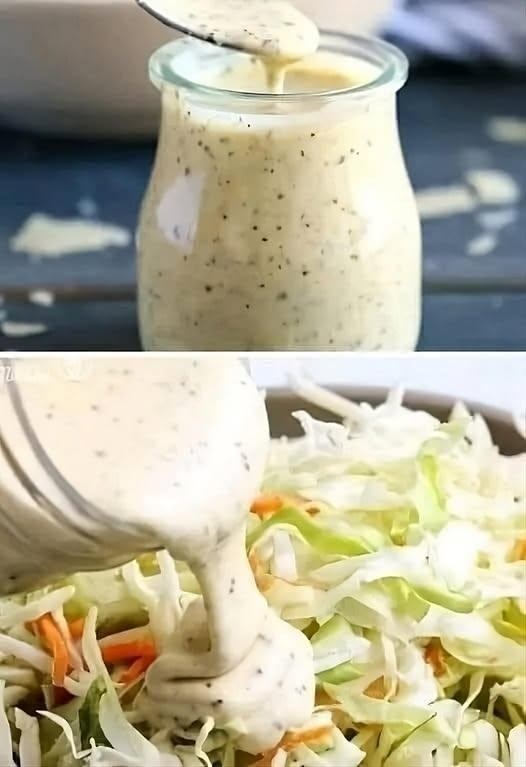ADVERTISEMENT
5. **Store the Dressing:**
Transfer the dressing into a glass jar with a tight-fitting lid. Store it in the pantry or your fridge. Thanks to the high vinegar content and salt, this dressing will last for several months. Just give it a shake before using, as some ingredients may settle over time.
### **Why This Dressing Lasts So Long**
The key to the longevity of this dressing lies in the ingredients:
– **Vinegar** is a natural preservative. It helps to prevent bacterial growth and spoilage, which is why the dressing can sit in your pantry for months without going bad.
– **Salt** acts as a preservative as well, helping to control moisture and maintain the freshness of the dressing.
– **Oil** does not spoil easily, especially if kept in a cool, dark place. Olive oil, which is rich in monounsaturated fats, also contributes to the dressing’s stability.
– The **Dijon mustard** helps the oil and vinegar emulsify, preventing the dressing from separating and ensuring that the texture remains creamy and smooth.
By using this method, you’re able to create a dressing that is not only better than most restaurant options but also shelf-stable for long periods, making it a practical solution for anyone who loves salad but doesn’t want to constantly make fresh dressing every week.
### **Variations and Customizations**
While the basic recipe is versatile and delicious on its own, there are many ways to tweak and personalize the dressing to suit your tastes.
#### **1. Different Types of Vinegar**
Experiment with different types of vinegar to give your dressing a unique flavor profile. Balsamic vinegar adds sweetness and depth, while red wine vinegar offers a sharper, more tangy flavor. Apple cider vinegar adds a milder, fruitier note, and white wine vinegar is light and refreshing.
#### **2. Add Fresh Herbs**
Fresh herbs like basil, parsley, or cilantro can brighten up the dressing. Dried herbs such as oregano, thyme, or dill can also be used if you want a more robust flavor. Be sure to finely chop the herbs before adding them to the dressing.
#### **3. Adjust the Sweetness**
If you prefer a sweeter dressing, you can increase the amount of honey or maple syrup. For a tangier dressing, simply add more vinegar. The balance between sweet and acidic is what makes the dressing so versatile.
#### **4. Add Heat**
For those who like a little spice, consider adding a pinch of **crushed red pepper flakes** or a dash of **hot sauce** to the dressing. This adds a layer of heat and complexity that can elevate the dressing, especially when paired with spicy greens like arugula or watercress.
#### **5. Use Different Oils**
While olive oil is the most common choice for salad dressings, you can experiment with other oils. **Avocado oil** provides a mild, buttery flavor that’s great for rich salads. **Grapeseed oil** is a lighter option with a neutral taste, while **sesame oil** can add an Asian flair when paired with soy sauce or rice vinegar.
—
### **Using Your Quick Salad Dressing**
This dressing can be used in a variety of ways, making it a great all-purpose addition to your kitchen. Here are some creative ways to incorporate this dressing into your meals:
1. **Classic Green Salad:** Drizzle the dressing over a simple mix of lettuce, spinach, or kale. Add some sliced vegetables, like cucumbers, tomatoes, and onions, for a refreshing and healthy salad.
2. **Roasted Vegetables:** Use the dressing as a marinade for roasted vegetables. It adds a tangy and savory depth of flavor to roasted carrots, potatoes, cauliflower, or Brussels sprouts.
3. **Coleslaw:** The dressing can be used as a base for a tangy coleslaw dressing. Mix it with shredded cabbage, carrots, and apples for a refreshing side dish.
4. **Grilled Meats:** Use the dressing as a marinade for chicken, pork, or beef. The acidity in the vinegar helps tenderize the meat, while the mustard adds an extra layer of flavor.
5. **Sandwiches and Wraps:** Drizzle the dressing on sandwiches, wraps, or grain bowls for added flavor and moisture.
—
### **Conclusion**
Creating your own salad dressing at home offers a world of flavor possibilities while allowing you to avoid the preservatives and unhealthy ingredients found in many store-bought dressings. This quick salad dressing, better than what you’d typically get at
a restaurant, offers the bonus of a virtually unlimited shelf life, thanks to the preserving power of vinegar and salt.
By following the basic recipe and experimenting with different oils, vinegars, and seasonings, you can create a dressing that is not only quick and easy but also personalized to suit your tastes. Whether you’re making a simple green salad or preparing a more complex meal, this dressing will elevate your dishes and keep for months, ensuring you always have a flavorful and healthy option at your fingertips.
